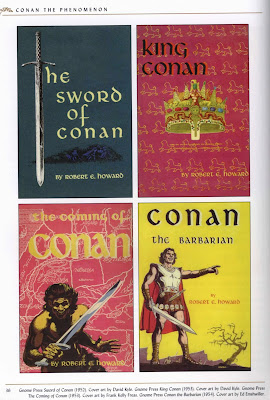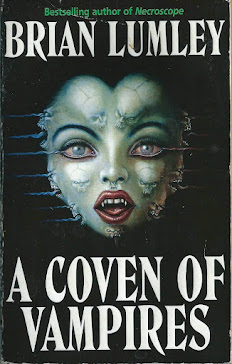January 22 marked the 78th year since the death of Robert E. Howard, so it's as good a time as any to take a look at 'Conan: The Phenomenon', which was published in hardcover by Dark Horse Books in 2008. The trade paperback version reviewed here was released in September 2013.
C:TP is essentially a coffee table book devoted to the famous barbarian; the author, Paul M. Sammon, is probably the world's foremost Conan Fanboy. The book, which measures 9 inches x 12 inches, is very well made, featuring glossy, high-quality paper and very good reproductions of the artwork, many examples of which occupy not just an entire page, but sometimes a double-page spread.
The book features a Foreword by Michael Moorcock, who, in tendentious prose, somehow re-casts the barbarian as freedom fighter devoted to the overthrow of oppressive, exploitative capitalist societies (!?)
It's no secret that Moorcock (like many British authors and artists in the sf and fantasy realms) regards Marxism with undisguised affection and reverence, but branding Conan as a hero of the Class Struggle seems more than a little contrived.....
Anyways, the opening chapter, 'Birth of A Barbarian', provides a biography of Robert E. Howard, along with a variety of archived photographs of the young REH out and about in Cross Plains, TX.
Sammon makes an effort here to refute the argument that REH was a Mamma's Boy with an Oedipal complex that obliged him to commit suicide following her death. Rather, Sammon believes that REH had planned all along to kill himself, but had delayed the act until the death of his mother, in order to spare her the trauma of discovering her only child had blown his brains out (despite the gunshot wound which pulverized a large portion of his brain, REH's robust constitution kept him alive, unconscious, for eight hours before he expired !).
The second chapter, 'Conan Rising', covers the publishing history of the Conan character following Howard's death in June, 1936, on till the late 1960s.
Sammon does a good job of explaining the convoluted nature of the legal agreements governing the franchise, agreements which led to a seemingly unceasing stream of lawsuits. It's difficult to come away from this chapter with anything other than dismay at the role L. Sprague de Camp (and to some extent Lin Carter) played in milking the REH canon for his own financial gain.
This chapter also gives deserved coverage to the pivotal role Frank Frazetta played in the marketing of the Lancer Books series of Conan adventures, a publishing move which brought the barbarian, and by extension REH's entire catalogue, into pop culture prominence.
'Conan the Ubiquitous' covers the further dissemination of the character into pop culture, occasioned by the arrival of the Conan comic book franchise, launched by Marvel in August of 1970.
This chapter reproduces covers and interior art of these comic books, and is sure to spark nostalgia in anyone who remembers seeing those comics on the rack in their drugstore of convenience store back in the day.
While Sammon gives appropriate credit to the role Barry Windsor Smith's artwork played in heightening the impact Conan had on the buying public, he over-praises (in my opinion) Roy Thomas, who wrote much of the content from 1970 - 1974 before taking over as editor-in-chief for Marvel.
Thomas, Stan Lee, and Martin Goodman were unwilling to recognize that Windsor-Smith had brought a new approach - modeled on European attitudes towards graphic art - to artistic quality as far as comic books were concerned. Lee and Goodman were loathe to part with the additional sheckels that would've retained Smith's services, as well as loathe to alter the publishing schedule to accommodate his intricate draftsmanship. Unsurprisingly, Windsor-Smith left Marvel, and to a great extent the entire comics industry, for greener pastures.
For me, the Windsor-Smith issues remain the apogee of the franchise's appearance in four-color comics.
'Conan the Thespian' is devoted to the two feature films, Conan the Barbarian (1982) and Conan the Destroyer (1984). There are stills, and insider accounts, of the movie-making process that may strike some readers as going overboard into vaguely disturbing realms of Fanboy territory ( a feeling reinforced by the photo of diminutive co-producer Edward Summer posing for a 'buddy photo' with an amiable Arnold Schwarzenegger).
The chapter also makes note of the exploitation of the REH estate throughout the 1980s and early 1990s, when a glut of Conan novels churned out by avaricious publishers (such as Tor Books) diluted the quality of the franchise.
The final chapter, 'Conan the Triumphant', deals with the franchise from the mid 90s to the late 2000s. Not surprisingly, since this is a Dark Horse book after all, Sammon gives plenty of favorable coverage to the efforts of Mike Richardson, the founder and publisher of Dark Horse comics, to acquire the licensing rights to revive the comic book Conan.
I haven't invested much effort to acquiring any of the Dark Horse Conan comics, with the exception of the Tim Truman / Joe R. Landsdale miniseries Conan and the Songs of the Dead. So I can't say if the Dark Horse incarnation does justice to the character or not, although Songs of the Dead certainly was a top-notch effort.
This chapter also covers the favorable changes to the handling of the REH franchise that came about in the mid- 1990s, when the Baum family of Texas inherited a majority of the publishing rights and acted to reduce the quantity of pastiches that had flooded the market with low-quality product.
As a result, high-quality volumes of the REH canon, including the Del Rey illustrated versions, provided readers for the first time with content that was free of the clumsy editorial decisions of de Camp and others.
'Conan: The Phenomenon' closes on an optimistic note, as the Del Rey lineup of R. E. Howard volumes promises to attract and sustain a new generation of Conan fans.
Whether you're a dedicated Conan Fanboy, or a fan of sci-fi and fantasy literature in general, its quality and affordability make Conan: The Phenomenon a worthwhile purchase.
























.jpg)
















